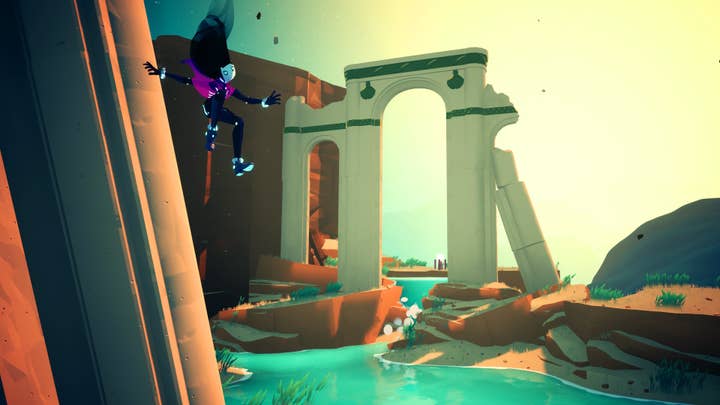How Solar Ash took Heart Machine out of its comfort zone
Alx Preston on the challenge of transitioning from 2D to 3D development and tips for small teams making a large scale open-world platformer
Game development is often about iteration as much as innovation. Given the difficulties of shipping any game, when a developer lands on a hit, it's natural to want to follow up in the same style or genre if not an outright sequel. It's not just because there's now a proven audience but the developer also has an opportunity to expand, improve, or refine a successful formula.
Heart Machine founder Alx Preston, however, wasn't going to stay in his comfort zone.
The developer's acclaimed title Hyper Light Drifter was a 2D top-down action RPG reminiscent of The Legend of Zelda: A Link to the Past with a vibrant pixelated aesthetic. While his next game is said to be set in the same universe, it couldn't be more different: Solar Ash is a 3D open world action platformer that takes more inspiration from the traversal of Super Mario 64 and Jet Set Radio, while its colossal bosses that inhabit the world conjure comparisons with Shadow of the Colossus.
It's more than a change in perspective or genre -- for one thing, Solar Ash is more focused on exploration and traversal than Drifter's combat -- but a far more ambitious and technically challenging undertaking, and that change in direction was an obvious progression for Preston.

"I felt like we'd done what we wanted to do in 2D," he says. "My goal is ultimately to create worlds that you can get lost in, and 3D is the best way to do that long-term."
The leap from 2D to 3D required a radical transition, not the least of which was learning Unreal Engine. It also involved growing Heart Machine from its core team of five during Hyper Light Drifter to around 25 people.
"It was probably the single biggest challenge, building out that team and then making sure that we have the right roles filled and making sure that we all work in as unified a manner as possible," Preston adds. "It's one of the reasons why Solar Ash has taken almost five years, because that transition from 2D to 3D required us to not only learn but also pull in people who are experts in their field."
While Drifter's sole animator Sean Ward had actually trained in 3D, Preston found familiarising himself with Unreal was a thorough and required education -- even though the studio was staffing up with people who already have that skill set.
"I put my due diligence in, otherwise I wouldn't be a very good creative director or producer, especially in the early days being the one motivating much of the design," he explains.
"I felt like we'd done what we wanted to do in 2D. My goal is ultimately to create worlds you can get lost in, and 3D is the best way to do that"
Unreal may unlock whole new possibilities compared to GameMaker (the engine behind Hyper Light Drifter) but it was also important to establish some limitations so that the team doesn't over-experiment and can actually finish the game.
But even with a larger team experienced in 3D development, Heart Machine is still operating at a fraction of the studios making huge expansive worlds. And in a game such as Solar Ash, which has a camera that wants to pull back to show just how small the player is, there's only so much manual labour that can be extracted in order to create such a vast world. To create that scale, the team relied on Houdini, a node-based procedural generation program used in film as well as games, including AAA titles like Marvel's Spider-Man and Horizon Zero Dawn, which Heart Machine used to generate much of the game's landscapes.
"It was a big concerted effort in the early days to get Houdini working, but it allowed us to rapidly build this larger space without the tedium of more traditional methods that otherwise would have cost us quite a bit more effort," says Preston.
Another example comes from the colossal boss creatures that roam the world, which he says aren't animated but motivated by an inverse kinematics system crafted by senior gameplay engineer Max Kaufman, so that the creatures can move where they need to go based on specific points laid down on the map.
"There's a lot of math that's driving those things and making them work instead of manually doing a ton of labour that otherwise would have made the project impossible to complete," Preston adds. "It's things like that where you need to find clever savings, which allows a small team to do things on such a massive scale."

While Hyper Light Drifter was still a collaborative project, it can also be seen as a more personal singular vision -- in part due to how its story of a character suffering from a terminal illness mirrors Preston's own struggles with congenital heart disease. Although he says that his original pitch for Solar Ash (originally known as Solar Ash Kingdom) was nonetheless "filled in pretty much every way", he acknowledges, "The connective tissue -- the different elements of story and character, the overall vibe and tone in different places -- has gone through many different iterations because of the scale of it, because of the sheer amount of labour that goes in to finish a game like this that I couldn't possibly wrangle every element."
"You need to find clever savings, which allows a small team to do things on such a massive scale"
It's why after being the game's acting game director initially, that role went to Chelsea Hash, who originally joined the team as a technical artist. With other members taking a lead role, there's essentially a lot more trust and creative freedom given in all the other disciplines.
"At the end of the day, there's plenty of crossover that happens on the creative side," says Preston. "But for me, the bigger difference is that I get to push on the higher level goals and trust that a lot of these other elements that really complete the thought will get pushed on by game direction, production, and so on."
The other challenge, as with every developer, has of course been getting Solar Ash finished while in the grip of a pandemic. While some roles had been remote, as a primarily in-person studio, Preston comments on how he prefers engaging face-to-face, away from screens.
"It's easier to just roll over to somebody or walk or call a meeting at any time or go up against the whiteboard and brainstorm together," he explains. "Suddenly having to pretty much schedule every encounter, there's a level of exhaustion there that can occur, and you miss on the nuance in cases and you also miss out on that kind of those natural conversations that end up happening in person.
"It's hard to complain too much about the scenario we're in, in that we get to keep our jobs and get to finish our project. But the reality is that working from home is not for everybody and there is a cost to that change and transition."

The real challenge, however, will begin when Solar Ash finally releases on December 2, following a short delay from its original October release. The assumed expectation is, as a larger, more ambitious title that's cost more time and money, that it will appeal to a much wider audience than Hyper Light Drifter. It certainly has a higher profile, backed by publisher Annapurna Interactive, while it was also revealed during Sony's Future of Gaming showcase for PlayStation 5 back in 2020. Preston on the other hand is a bit more cautious on expectations, acknowledging that the shift to 3D also changes the audience in mind.
"It's a bit of an apples and oranges comparison not just because of traversal versus combat but because of the nature of a third person freeform camera versus fixed view 2D," he says. "There are people that just will not play third-person camera games like that, because they don't have that skillset. That alone creates this conversation around difficulty because you're already asking some players a whole lot to make sure they can navigate this world comfortably."
Fortunately, the fact that Solar Ash is more focused on traversal over combat should mean it's a less punishing game than Hyper Light Drifter's intimidating boss fights, while Preston confirms there are also a few difficulty modes.
"We've been playtesting the heck out of it and hoping that we can get that bigger, broader coverage that's required because of the higher threshold required for a lot of players. Ultimately, the hope is that we did enough good stuff there to provide as many players as possible an experience that they enjoy, but you can't serve everybody."

